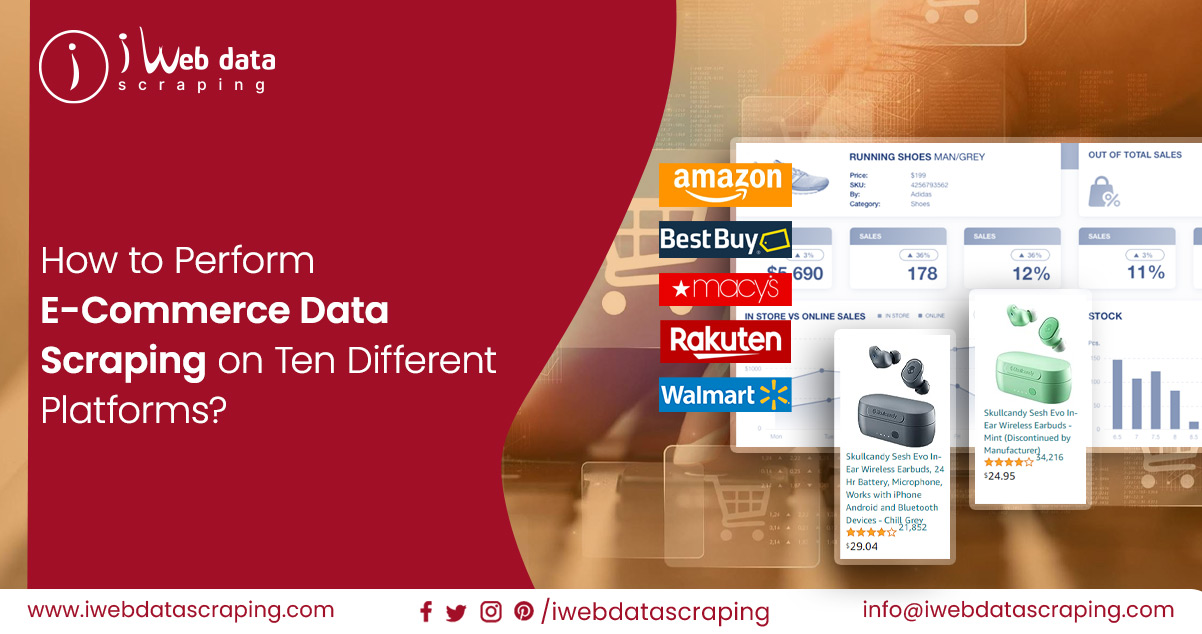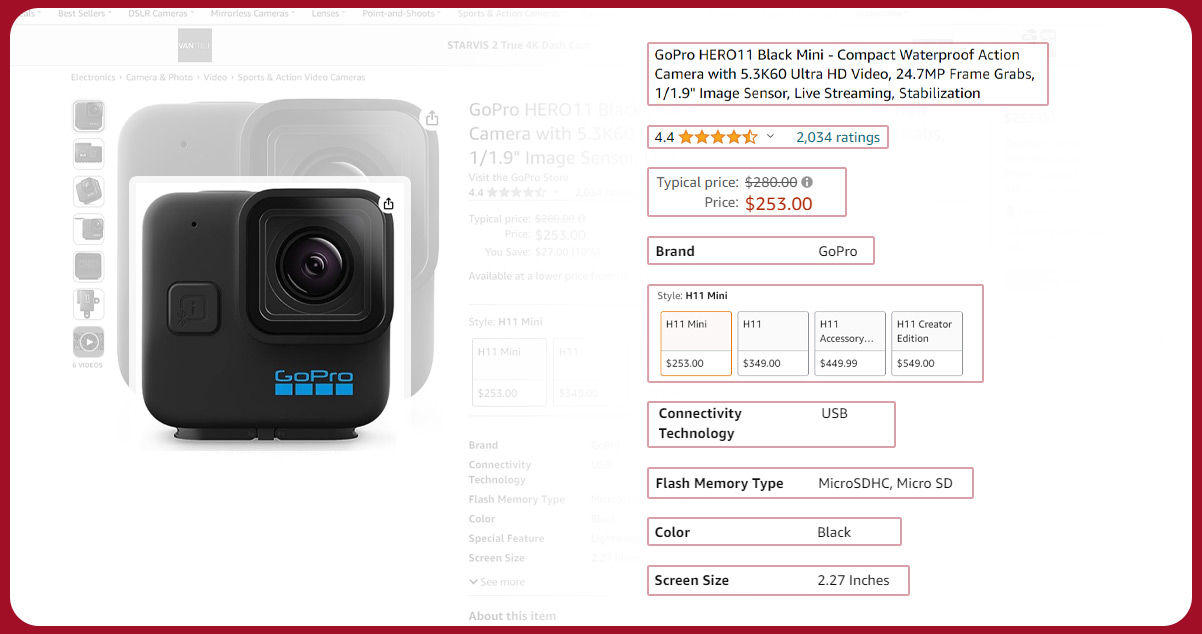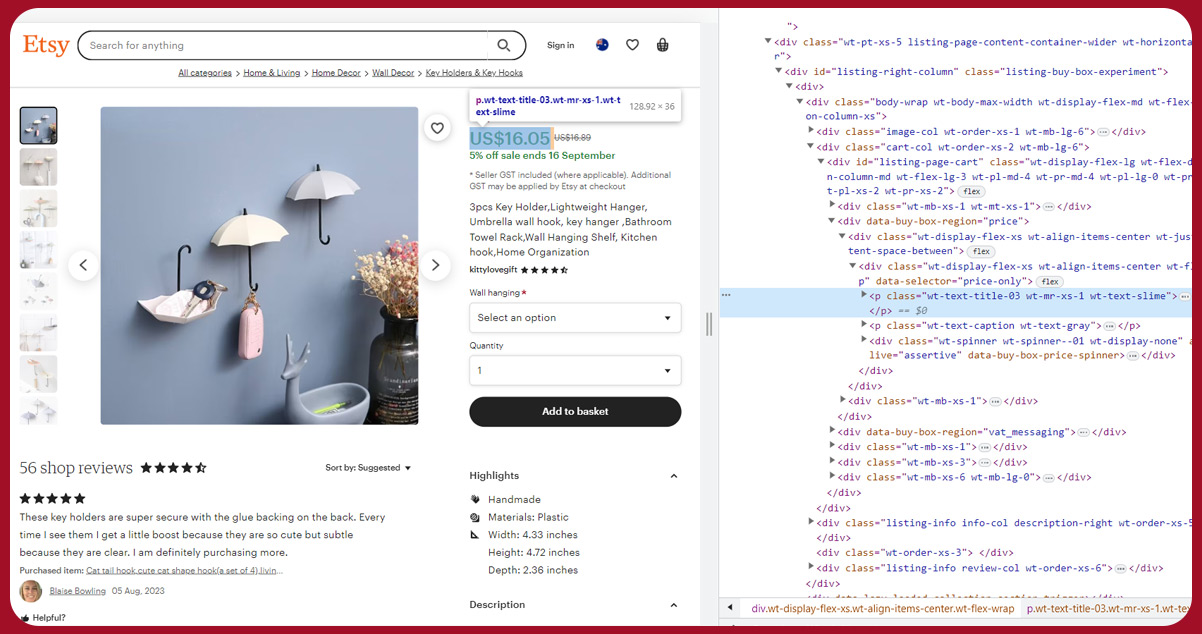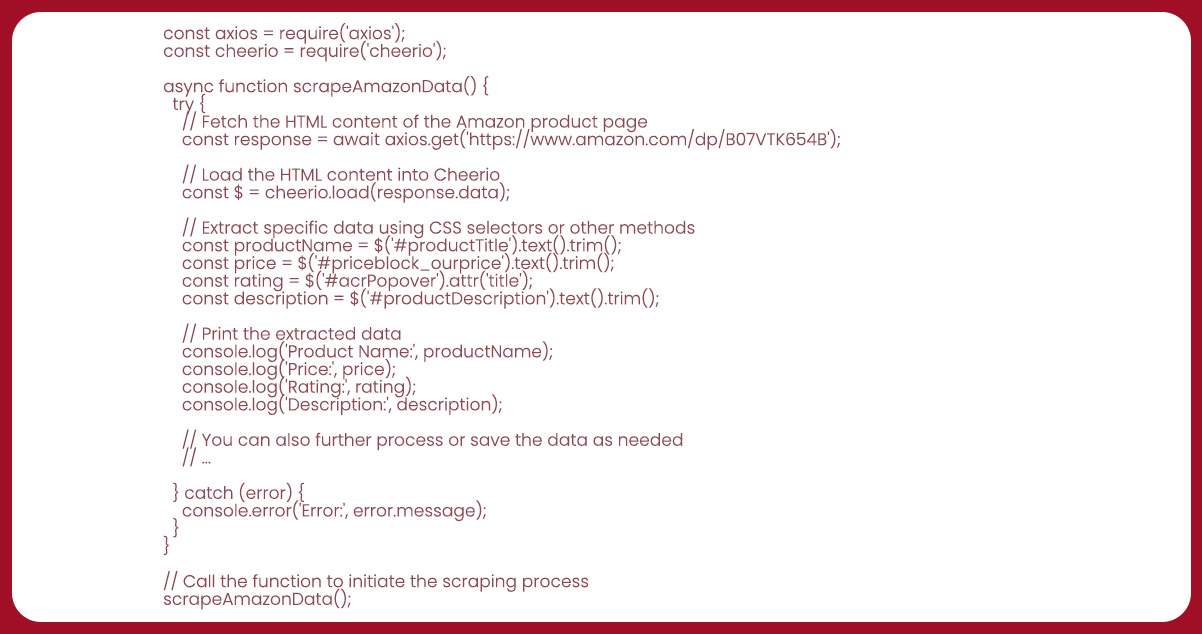
Web scraping, also called data scraping, is a potent method for extracting valuable information from e-commerce platforms such as Amazon and Walmart. Using programming languages like JavaScript and the querySelector function, one can systematically gather the necessary data to enhance decision-making processes. In this article, we will delve into the efficient data extraction from e-commerce websites on a large scale and underscore the significance of this practice. We will explore various techniques and optimal approaches b, along with guidance on leveraging JavaScript and querySelector for data extraction.


AMAZON: Amazon's e-commerce website is a global retail juggernaut that has revolutionized online shopping. Amazon has become synonymous with convenience and choice, offering an unparalleled selection of products across a multitude of categories. With a user-friendly interface, customers can effortlessly navigate through an extensive array of items, read detailed product descriptions, and make informed decisions based on user reviews and ratings. Scrape Amazon e-commerce data for competitive analysis.
Rakuten: Rakuten's e-commerce website is a prominent global online marketplace offering a diverse range of products and services to customers worldwide. Originally founded in Japan, Rakuten has expanded its presence to become a multifaceted platform that connects consumers with an extensive array of goods, from electronics and fashion to books and home essentials. Scrape Rakuten e-commerce data for price optimization.
TARGET: Target's e-commerce website is a well-established and popular online retail destination in the United States. Known for its wide range of products spanning categories like electronics, home and furniture, clothing, beauty, groceries, and more, Target offers a comprehensive shopping experience to its customers. The website features a user-friendly interface, enabling shoppers to browse and search for products, read detailed product descriptions, and view customer reviews. Scrape Target e-commerce data for market research.
MACY'S: Macy's e-commerce website is a prominent online retail platform that complements the well-known brick-and-mortar department store chain. By catering to diverse consumer needs, Macy's online platform offers various products spanning fashion, beauty, home goods, electronics, and more. The website provides an intuitive and user-friendly interface, making it easy for customers to navigate, search for products, and explore various categories. Scrape Macy's e-commerce data for inventory management.
BEST BUY: Best Buy's e-commerce website is a leading online destination for consumer electronics, appliances, and technology products in the United States and beyond. Renowned for its extensive selection of products, it caters to a wide range of tech enthusiasts, home appliance shoppers, and entertainment seekers. The website boasts a user-friendly interface that simplifies product discovery, allowing customers to browse, compare, and purchase items effortlessly. Scrape Best Buy e-commerce data for content aggregation.
eBay: eBay is a globally recognized and influential e-commerce platform that connects buyers and sellers worldwide. Founded in 1995, eBay has become one of the largest online marketplaces, facilitating the sale of a wide variety of new and used goods. The platform's unique auction-style listings and traditional fixed-price listings offer a diverse and dynamic shopping experience. Scrape eBay e-commerce data for dynamic pricing.
WALMART: Walmart's e-commerce website is a significant online extension of one of the world's largest retail chains. Founded in 1962, Walmart has established itself as a retail giant with a diverse range of products, and its e-commerce platform reflects this breadth and depth. The website offers customers a convenient and extensive shopping experience focusing on value, variety, and accessibility. Walmart's e-commerce website includes many products, including groceries, electronics, apparel, and home goods. Users can browse products easily, read detailed descriptions, and explore customer reviews to make informed purchasing decisions. Scrape Walmart e-commerce data for customer sentiment analysis.
ETSY: Etsy's e-commerce platform is a unique and thriving online marketplace specializing in handmade, vintage, and craft items. Founded in 2005, Etsy has grown into a global community of artisans, crafters, and vintage collectors who sell their one-of-a-kind and creative products on the platform. Etsy's website provides a distinctive and personalized shopping experience, catering to those seeking handmade or unique items. The heart of Etsy's e-commerce website is its diverse catalog of products, including handmade jewelry, clothing, home decor, art, and vintage collectibles. Scrape Etsy e-commerce data for demand forecasting.
Alibaba: Alibaba's e-commerce platform is one of the world's largest and most influential online marketplaces. Founded in 1999 by Jack Ma, Alibaba has grown into a global e-commerce and technology conglomerate with a diverse portfolio of businesses. Alibaba's primary e-commerce websites include Alibaba.com, Taobao, Tmall, and AliExpress, each catering to different markets and customer needs. Alibaba.com is a business-to-business (B2B) platform that connects manufacturers, wholesalers, and suppliers with global buyers. Scrape Alibaba e-commerce data for price comparison.
THE HOME DEPOT: The Home Depot's e-commerce website is a leading online home improvement and construction retail platform. Founded in 1978, The Home Depot has become one of the largest home improvement retailers globally, with physical stores and a robust online presence. The Home Depot's e-commerce website offers many products and services tailored to homeowners, contractors, and do-it-yourself enthusiasts. Customers can explore many items, including building materials, tools, appliances, home decor, gardening supplies, and more. Scrape The Home Depot e-commerce data to understand buying behavior.

In today's digital era, data holds immense value, driving decision-making, fostering innovation, and enhancing competitiveness across various industries. Data scraping e-commerce websites emerged as a crucial process for extracting insights and supporting informed business decisions, especially when dealing with renowned websites like Amazon and Walmart.
Before diving into data extraction from these websites, it's paramount to grasp the concept of data and identify the specific data types that align with your business objectives. It may encompass collecting diverse data types, such as Product Details Pages (PDPs), search results, seller profiles, customer reviews, ratings, travel and booking data, event information, ticket details, and other pertinent data points.
Web scraping stands out as the most prevalent technique for data extraction, involving the retrieval of information from the HTML code of websites. A fundamental aspect of successful data scraping involves comprehending the website's structure and pinpointing the desired data locations, including product details pages (PDPs). Amazon and Walmart, as two prominent e-commerce platforms, often serve as targets for data extraction efforts. Employing tools and programming languages like JavaScript and Python can streamline the data extraction process from these websites. Nonetheless, scaling up data extraction can introduce challenges, including the need for proxies and strategies to evade anti-bot detection mechanisms.

As a business owner, you understand the critical importance of an in-depth understanding of your products to succeed. Comprehensive knowledge of each product, including pricing and specifications, is essential. However, manually collecting such information can be daunting and time-consuming, especially when dealing with a substantial inventory.
It is precisely where data scraping proves invaluable. Data scraping techniques to extract product details from websites enable you to efficiently compile all the information required to enhance your Product Details Pages (PDPs). After determining the specific data types that align with your business model, you can utilize the extracted data for various purposes, including Market Intelligence, Pricing and Competitor Analysis, Product Research and Development, Customer Sentiment Analysis, Inventory Management, and Demand Forecasting.

JavaScript stands out as one of the most widely employed programming languages in web development, and its versatility extends to data extraction from websites. JavaScript can be a powerful tool for scraping data from web pages, including valuable information like product descriptions, prices, images, reviews, and more.
Here's a breakdown of how JavaScript extracts data from e-commerce websites efficiently:
Inspect the Webpage: Begin by inspecting the webpage to pinpoint the specific HTML elements containing the data you intend to scrape. The browser's developer tools are handy for this task, allowing you to delve into the webpage's HTML code.
Leverage DOM Manipulation: You can utilize DOM (Document Object Model) manipulation techniques after identifying the HTML elements housing your target data. It uses JavaScript to access and modify these HTML elements, enabling data extraction.
Data Parsing: It is typically unstructured once the data is from HTML elements. You need to parse it into a structured format like JSON or CSV to make it usable. Parsing transforms the raw data into a structured form for analysis.
Automation: For large-scale data extraction from e-commerce websites, automation is critical. While you can write a JavaScript script to automate scraping, employing specialized web scraping tools or programming languages like Python is often more efficient.
Handling Anti-Scraping Measures: Many e-commerce sites employ anti-scraping measures like CAPTCHAs and IP blocking to deter web scrapers. These measures may require rotating proxies or CAPTCHA-solving services to ensure smooth data extraction.
Libraries like Axios and Cheerio are popular in the JavaScript ecosystem for web scraping and handling HTTP requests. Below is a sample example demonstrating data extraction using Node.js and query selectors. Remember that while this example fetches data from a sample website, you would need to transfer this data into a readable format, such as CSV, JSON, or Parquet, for further analysis.


E-commerce data scraping offers valuable insights and competitive advantages but comes with challenges and limitations.
Dynamic Website Changes: One major challenge is the ever-evolving nature of e-commerce websites. These platforms frequently update their designs, making it challenging to develop consistent scraping scripts for reliable data extraction. Furthermore, some e-commerce sites employ anti-scraping techniques like CAPTCHAs or IP blocking to deter automated scraping.
Vast Data Volumes: The sheer volume of data on e-commerce websites can be overwhelming. With millions of products available, large-scale data extraction with e-commerce data scraping services can strain resources and consume significant time. Practical scraping tools must efficiently manage large datasets without causing server overload or technical complications.
Ethical Considerations: Ethical concerns also come into play in e-commerce data scraping. Some scraping practices using e-commerce data scraper may infringe upon copyright laws or violate a website's terms of use, potentially leading to legal repercussions. Moreover, scraping that involves accessing customer data such as emails or purchase histories can be perceived as an invasion of privacy, raising ethical questions.
Navigating these challenges and respecting ethical boundaries is essential for successful and responsible e-commerce data scraping.
Get in touch with iWeb Data Scraping today for more information! Whether you require web scraping service and mobile app data scraping, we've covered you. Don't hesitate to contact us to discuss your specific needs and find out how we can help you with efficient and reliable data scraping solutions.